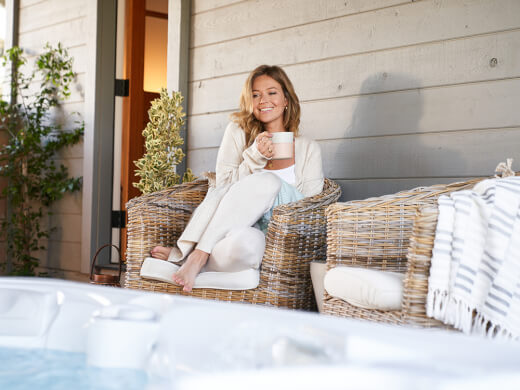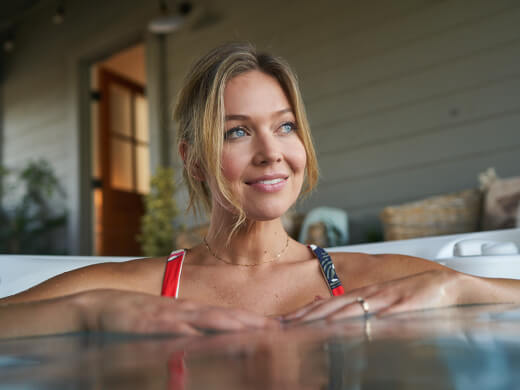Exploring the Rise of Aquatic Exercise and Stretching.
With the growing number of specialized classes offered at public pools, swim clubs, and fitness centers, aquatic fitness is becoming increasingly popular. Thanks to the unique properties of water, participants can enjoy a safe and effective workout without some of the challenges that come with an outdoor or gym workout.
For example, the resistance you feel when moving in water makes workouts more challenging and can deliver a larger calorie burn in less time. Additionally, water's natural buoyancy supports muscles and joints so there's generally less impact and risk of injury than with land-based exercises. These low-impact benefits make aquatic exercise an attractive choice for seniors, individuals with joint issues, and those recovering from injuries.
Furthermore, the temperature-controlled environment of a swimming pool or hot tub makes exercise more comfortable in a variety of weather conditions - so it's easier and more pleasant to stick to your wellness routine.
Let's dive into the world of aquatic exercise to see why it's making such a splash.
Table of Contents.
- What is Aquatic Exercise?
- Top Benefits of Aquatic Exercise.
- Enhance Your Heart Health.
- Stretching in Water Keeps You Fit and Flexible.
- Begin and End Your Session with a Stretch.
- Explore Popular Group Fitness Programs.
- Water-Based Fitness for Everyone.
- Aquatic Exercise and Stretching: Getting Started.
- Five Simple Water Exercises You Can Do in a Pool.
- Stretching Exercises for Hot Tubbers.
1. What is Aquatic Exercise?
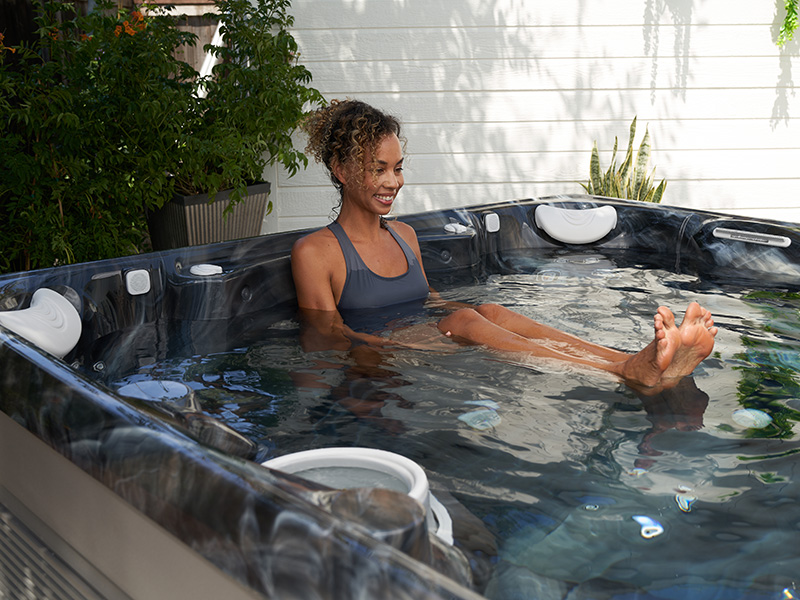
Aquatic exercise refers to cardio, strength-building, or stretching performed in water that's typically waist- to chest-deep. These low-impact activities allow just about anyone, regardless of fitness level, age, or swimming ability, to stay active and improve their health, strength, and mobility. Popular exercises include water aerobics, aquatic yoga, water jogging, and resistance training, each of which leverages the unique properties of water for a safe and effective workout.
Many strength-building water exercises, like walking in waist-deep water, depend only upon resistance. However, there are also fitness accessories available to help enhance aquatic workouts and target specific muscle groups, including water dumbbells, kickboards, resistance bands, and pool noodles. These tools are designed to enhance water exercise by adding resistance to make muscles work harder without adding stress on the joints.
When deciding on the type of aquatic exercise to participate in, consider the size of the hot tub or pool you have access to. For example, a large swimming pool in a gym or community center will have ample space for water jogging and large group exercises, while smaller home pools are well suited for walking in place, kickboard workouts, and strength training with water weights and resistance bands.
Buying a hot tub for your home is a great way to make aquatic fitness more accessible. A local hot tub dealer can help you find the right shape, size, and price range for your needs. While a hot tub's smaller size limits the range of possible exercises, its warm water and molded seats are perfectly suited for resistance workouts, gentle stretching, and yoga poses. Plus, the hydrotherapy benefits of a hot tub could aid muscle recovery, making it easier to stick to your active routine.
2. Top Benefits of Aquatic Exercise.
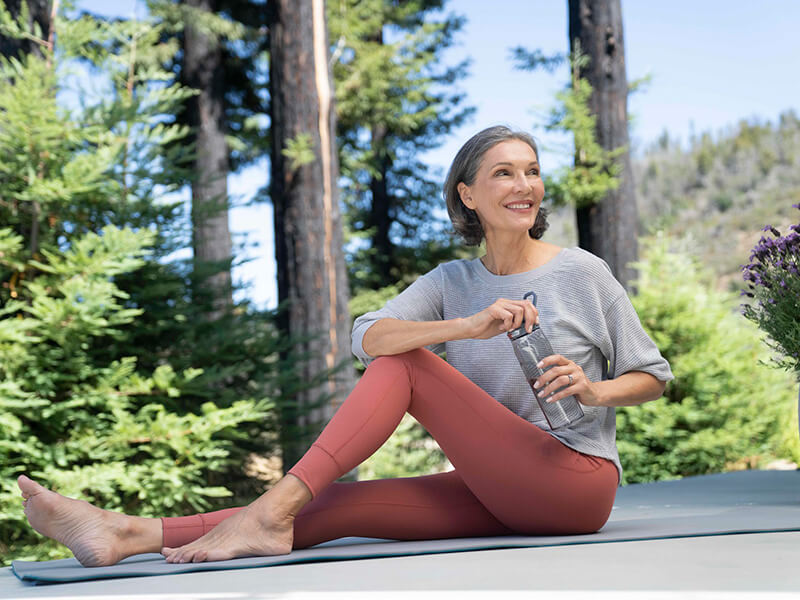
Regardless of your fitness levels or goals, there are plenty of good reasons to give water-based exercise a try:
- Exercising in waist- to chest-deep water provides low-impact resistance, so you'll burn more calories in less time while fully engaging your muscles.
- Aquatic exercise is efficient, providing a cardio workout that also boosts strength, endurance, and flexibility.
- Extreme temperatures won't get in the way of your fitness ritual. Regardless of the weather, your pool will keep you cool in the summer, and can be heated to keep you comfortably warm in winter. Even some hot tub models offer a cool water mode that can be used for exercising or cool water soaking.
- The buoyancy of water supports your body, so you can work out harder with less impact and risk of injury than traditional land exercises.
- You have plenty of options to choose from. Look for an aqua fitness class at your local gym or community center, work out in your pool with water weights and resistance bands, or have fun working on flexibility with hot tub yoga moves and stretches.
- Aquatic exercise is refreshing and fun - you'll feel like a kid again while you work toward achieving your fitness goals.
3. Enhance Your Heart Health.
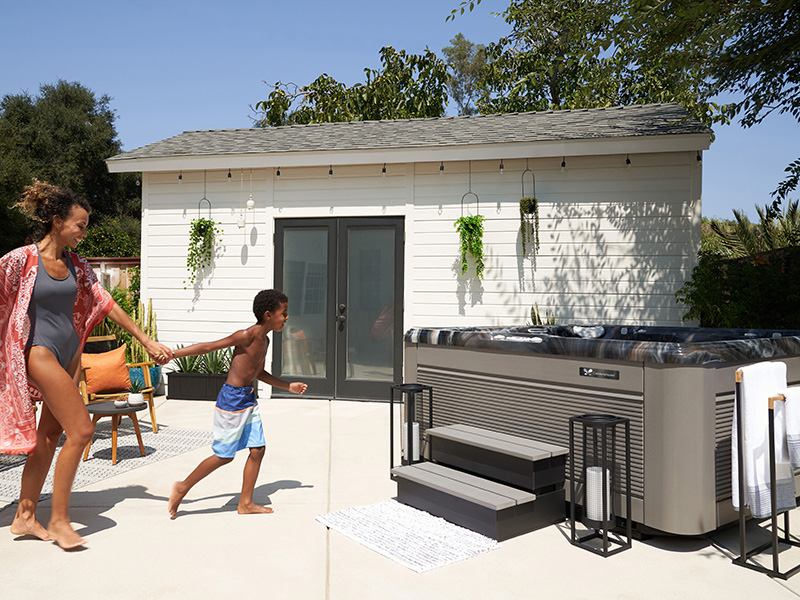
Certain studies have stated that aquatic exercise may be helpful for patients who are suffering from Coronary Artery Disease. Regular aerobic exercise can lower blood pressure and improve markers of cardiovascular health such as exercise capacity, vascular function and heart rate variability. The buoyancy of water provides a gentle, low-stress environment for this type of activity, aiding relaxation and helping reduce blood pressure. Additionally, aquatic workouts burn calories, contributing to weight loss and decreased fat mass, which also supports lower blood pressure. This combination of benefits makes aquatic exercise an excellent choice for maintaining heart health.
4. Stretching in Water Keeps You Fit and Flexible.

Regular stretching is an important part of any fitness routine because it enhances flexibility, improves range of motion, and reduces the risk of injuries. As we age, it's important to keep joints and muscles flexible and healthy. Without regular stretching, muscles can shorten and become tight, with limited range of motion. This can impair the ability to participate in sports and other activities, and could increase the risk of joint pain, strains, and muscle soreness.
To stay flexible and mobile, it's best to commit to more than just the occasional stretch. Dedicating a few minutes each day to water stretching exercise in a hot tub is an easy and effective way to see consistent results. The warmth of the water helps relax muscles and increase blood circulation, while the water's buoyancy reduces strain on joints, making it easier to perform stretches safely. This winning combination of heat and buoyancy creates an optimal environment for enhancing flexibility, alleviating muscle tension, and providing the benefits of stretching in a comfortable, enjoyable environment.
5. Begin and End Your Session with a Stretch.
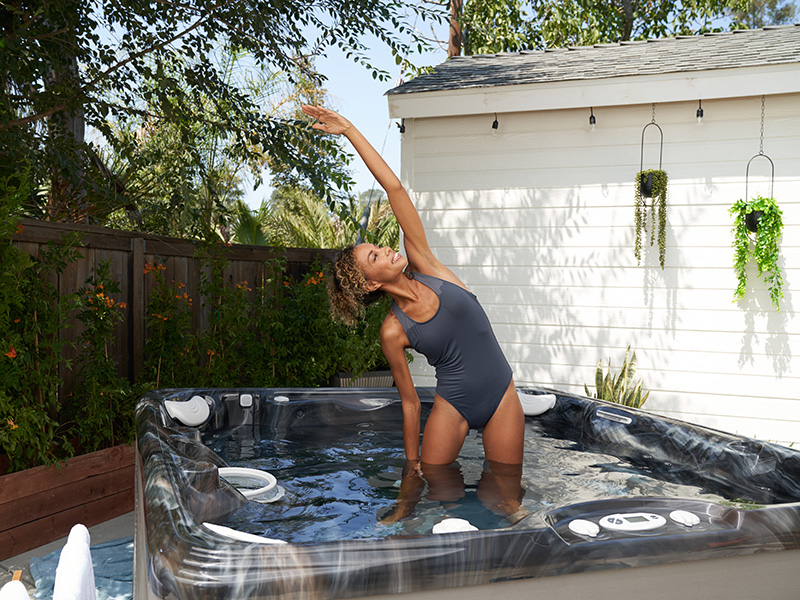
During aquatic exercise, your muscles are cushioned by the water, so you won't feel the impact in the same way you would if you were running or exercising on land. However, the muscles are still working just as hard against the water's resistance, which is why it's important to stretch before and after water-based activities. Perform dynamic (moving) stretches before your session to warm up and prepare your muscles for the exercises. Static stretching (where you hold the stretch) after your workout will do wonders to flush out lactic acid and soothe tight muscles, and if there's a hot tub available, a rejuvenating hydrotherapy massage will feel great while loosening joints and aiding muscle recovery.
6. Explore Popular Group Fitness Programs.
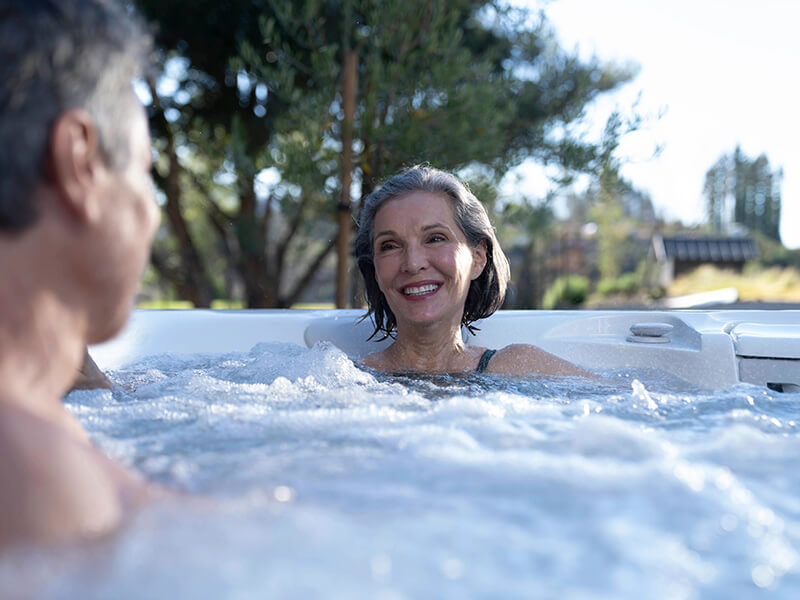
For a workout that blends fitness with fun, check out one of the trending water-based fitness classes at your local gym or community pool. Popular aquatic fitness programs combine the low-impact resistance benefits of aquatic fitness with the social aspect of exercising with friends.
Aqua Zumba, a popular class for all levels, combines Zumba dance moves with water resistance, creating an energetic workout that's easy on the joints. For a more advanced option, Hydro Power focuses on high-intensity interval training (HIIT) in the water, incorporating sprints, jumps, and resistance training to build strength and endurance. These programs appeal to a range of individuals, from those seeking a guided, low-impact environment for rehabilitation to exercise enthusiasts looking for a challenging alternative to their regular routine.
7. Water-Based Fitness for Everyone.

Aquatic exercise is a good option for people of all ages and fitness levels. Children and young adults will enjoy exploring new ways to stay fit and have fun in the water. For older adults, the water's buoyancy reduces strain on joints and lowers the risk of injury, making it a safe choice for those suffering from arthritis or osteoporosis, or recovering from surgery.
People with mobility issues, even those confined to a wheelchair, find exercising in water more comfortable and less intimidating because it supports the body and reduces the risk of muscle or joint pain. Water exercise is a safe, effective, and enjoyable way for everyone to keep fit and healthy.
8. Aquatic Exercise and Stretching: Getting Started.

If you're ready to experience the benefits of aquatic fitness and water stretching exercises, there are several ways to get started, from private pools and hot tubs to community centers and gyms. While a backyard pool is a bigger investment, hot tubs can be more approachable in terms of price and space. You can find local hot tub prices by contacting a local dealer, but whether you invest in your own water oasis or rely on a public option, the first step is easy: Just dive in!
Check YouTube for online tutorials or start with a few of the exercises outlined below. Wear a comfortable swimsuit that you can move in, some lightweight water shoes to avoid slipping, and don't forget to slather on waterproof sunscreen.
Once you've tried some simple exercises using the water for resistance, you might want to purchase some basic equipment like water dumbbells or resistance bands to enhance your workouts. Don't forget to modify the exercises as needed to suit your fitness level and goals.
If you prefer the comradery and structure of an exercise class to working out solo, a group water aerobics class might be the best choice for you. Check with your local community center, gym, or YMCA for available sessions.
If you're a senior seeking to try water aerobics or an aquatic group exercise class, contact your gym or senior center for information. Or explore your options on the Silver Sneakers website, which is a program that provides free access to gyms and fitness classes for eligible adults aged 65 and up.
9. Five Simple Water Exercises You Can Do in a Pool.*
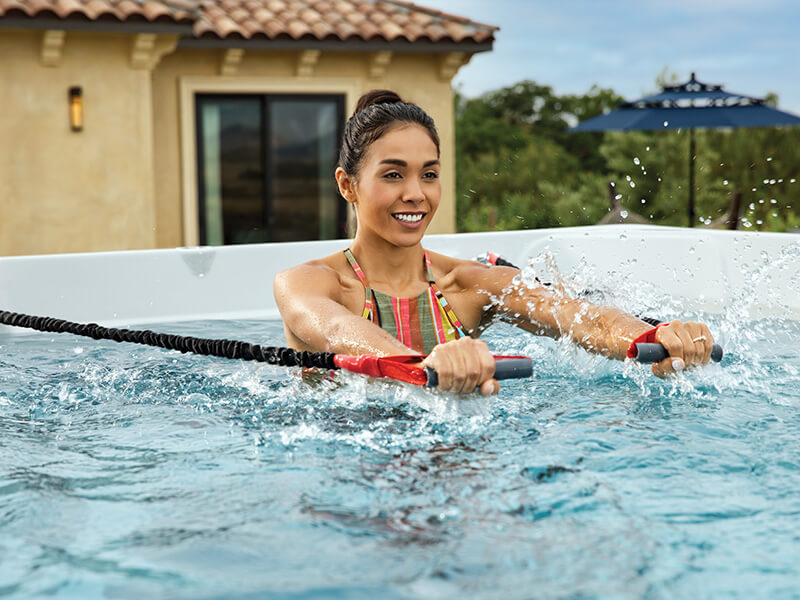
- Water Walking or Jogging: Walk or jog across the shallow end of the pool, with the water no higher than mid-chest level, keeping your back straight and using your arms to help with balance. This exercise will get your heart pumping and enhance core and leg strength.
- Leg Lifts: Position yourself in front of and facing the pool wall, holding on the edge for support, and lift one leg to the side, then bring it back down. Repeat for a set of 10-15 reps and switch legs. This is an effective way to target hips and thighs.
- Arm Curls: Holding water dumbbells, stand in the water with your arms at your sides. While pinning your elbows to your body, curl your arms up to your shoulders and then lower them back down. This simple exercise will work your biceps and triceps.
- Flutter Kicks: Hold onto the edge of the pool or use a kickboard and extend your legs behind you. Perform quick, small kicks to work your core and leg muscles.
- Water Bicycle: In the shallow end, lean your back against the pool wall, extend your arms along the sides for support, and pedal your legs as if riding a bicycle for a simple leg/cardio workout.
10. Stretching Exercises for Hot Tubbers.
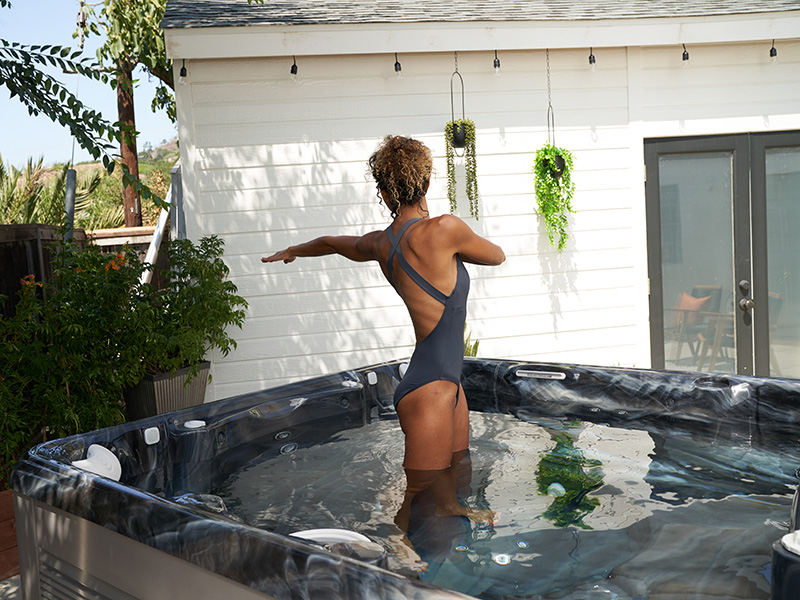
Stretching in a warm hot tub does more than feel good. Warm water hydrotherapy can enhance the effects of stretching and improve flexibility and mobility.
Here are a few simple stretches to try.* For the best results, hold each stretch for at least 15-30 seconds per side.
Neck Stretch:
- Sit comfortably with your back straight and hands resting on your thighs.
- Gently tilt your head to one side, bringing your ear towards your shoulder.
- Repeat, leaning your head to the other shoulder.
Shoulder Stretch:
- Sit or stand with shoulders relaxed.
- Reach one arm across your chest and use the opposite hand to gently press the arm towards your chest.
- Repeat with the opposite arm.
Torso Twist:
- Sit comfortably with your feet flat on the floor of the hot tub.
- Place one hand on the opposite knee and gently twist your torso, looking over your shoulder.
- Repeat, looking over the opposite shoulder.
Quadriceps Stretch:
- Stand in the hot tub and hold onto the edge for balance.
- Bend one knee and bring your heel up behind you until you can touch it.
- Use your hand to hold your ankle and gently pull it towards you.
- Repeat with the opposite leg.
Calf Stretch:
- Stand facing the wall of the hot tub and place both hands on it for support.
- Step one foot back, keeping it flat on the floor and your leg straight.
- Bend your front knee and lean forward slightly to stretch the calf of the back leg.
- Repeat with the opposite leg.
These stretches can help improve flexibility, reduce muscle tension, and enhance overall relaxation. Always move gently and listen to your body to avoid overstretching.
Experience the wellness benefits of soaking and stretching in a hot tub. Your Caldera Spas dealer is standing by to answer your questions about hot tub hydrotherapy, and help you select a hot tub that fits your space and budget.
*Consult your physician before starting any sort of exercise routine. Exercise at your own risk.
Related Articles.
Find a Dealer.

Find a Dealer.
Count on your local Caldera Spas dealer to help make your experience easy and enjoyable.

